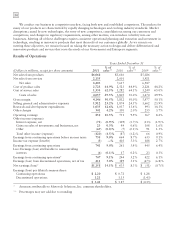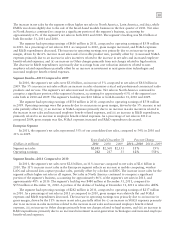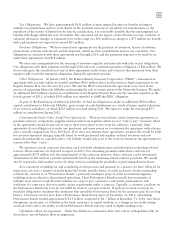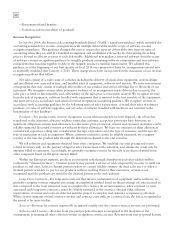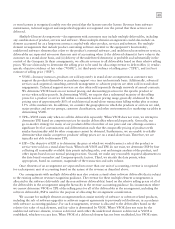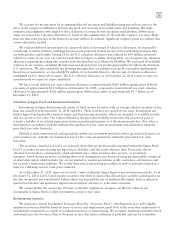Motorola 2011 Annual Report Download - page 49
Download and view the complete annual report
Please find page 49 of the 2011 Motorola annual report below. You can navigate through the pages in the report by either clicking on the pages listed below, or by using the keyword search tool below to find specific information within the annual report.
43
Capital Expenditures: Capital expenditures were $186 million in 2011, compared to $192 million in 2010
and $136 million in 2009. Capital spending in 2011 as compared to 2010 was generally flat across all functions
except for the slight decrease in our service function, offset by higher information technology capital spend. Capital
spending in 2009 was lower across all functions as compared to 2010 and 2011, but was higher in our service
organization as a number of our owned networks required capital upgrades.
Sales of Investments and Businesses: We received $1.1 billion in net proceeds from the sales of investments
and businesses in 2011, compared to $264 million in 2010 and $357 million in 2009. The $1.1 billion in proceeds
in 2011 were primarily comprised of net proceeds received in connection with sales of: (i) Networks business,
(ii) Wireless Broadband businesses, (iii) certain of our equity investments, and (iv) the Israel-based module business.
The $264 million in proceeds in 2010 were primarily comprised of our Israel-based wireless network operator
business and the sale of a single investment.
Financing Activities
Net cash used for financing activities was $5.5 billion in 2011, compared to $40 million in 2010 and $277
million in 2009. Cash used for financing activities in 2011 was primarily: (i) $3.4 billion of contributions to
Motorola Mobility, (ii) $1.2 billion used for repayment of long-term debt, (iii) $1.1 billion of cash used for
repurchases of shares, and (iv) $72 million of cash used for payment of dividends, partially offset by $192 million of
net cash received from the issuance of common stock in connection with our employee stock option plans and
employee stock purchase plan.
Cash used for financing activities in 2010 was primarily $1.0 billion of cash used for the repayment of long-
term debt, partially offset by: (i) $797 million of cash provided by distributions from discontinued operations, and
(ii) $179 million of cash received from the issuance of common stock in connection with our employee stock option
plans and employee stock purchase plan.
Current portion of Long-Term Debt: At December 31, 2011, our current portion of long-term debt was $405
million, compared to $605 million at December 31, 2010. In November 2011, we repaid, at maturity, the entire
$600 million aggregate principal amount outstanding of our 8.0% Notes due November 1, 2011.
Long-term portion of Long-Term Debt: At December 31, 2011, we had outstanding long-term debt of
$1.1 billion, compared to $2.1 billion at December 31, 2010.
During the year ended December 31, 2011, we repurchased $540 million of our outstanding long-term debt for
a purchase price of $615 million, excluding approximately $6 million of accrued interest, all of which occurred
during the three months ended July 2, 2011. The $540 million of long-term debt repurchased included principal
amounts of: (i) $196 million of the $314 million then outstanding of the 6.50% Debentures due 2025 (the “2025
Debentures”), (ii) $174 million of the $210 million then outstanding of the 6.50% Debentures due 2028 (the “2028
Debentures”), and (iii) $170 million of the $225 million then outstanding of the 6.625% Senior Notes due 2037
(the “2037 Senior Notes”). After accelerating the amortization of debt issuance costs and debt discounts, we
recognized a loss of approximately $81 million related to this debt tender in Other within Other income (expense)
in the condensed consolidated statements of operations.
In November 2010, we repaid, at maturity, the entire $527 million aggregate principal amount outstanding of
our 7.625% Notes due November 15, 2010. During the year ended December 31, 2010, we repurchased
approximately $500 million of our outstanding long-term debt for a purchase price of $477 million, excluding
approximately $5 million of accrued interest, all of which occurred during the three months ended July 3, 2010. The
$500 million of long-term debt repurchased included principal amounts of: (i) $65 million of the $379 million then
outstanding of the 2025 Debentures, (ii) $75 million of the $286 million then outstanding of the 2028 Debentures,
(iii) $222 million of the $446 million then outstanding of the 2037 Senior Notes, and (iv) $138 million of the
$252 million then outstanding of the 5.22% Debentures due 2097. After accelerating the amortization of debt
issuance costs and debt discounts, we recognized a loss of approximately $12 million related to this debt tender in
Other within Other income (expense) in the consolidated statements of operations.
The three largest U.S. national ratings agencies rate our senior unsecured long-term debt investment grade. We
believe that we will be able to maintain sufficient access to the capital markets at our current ratings. Any future
disruptions, uncertainty or volatility in the capital markets may result in higher funding costs for us and adversely
affect our ability to access funds.



